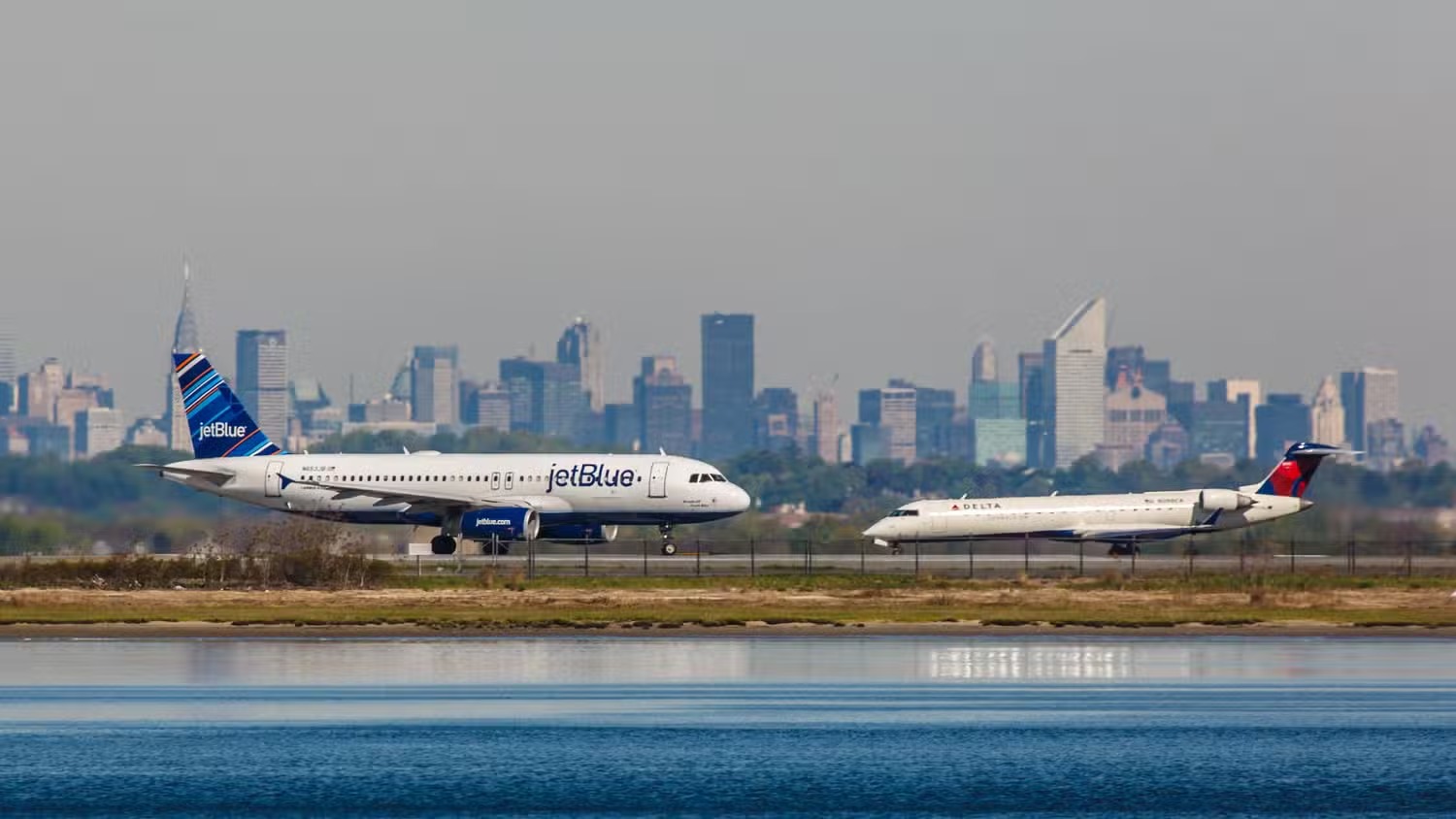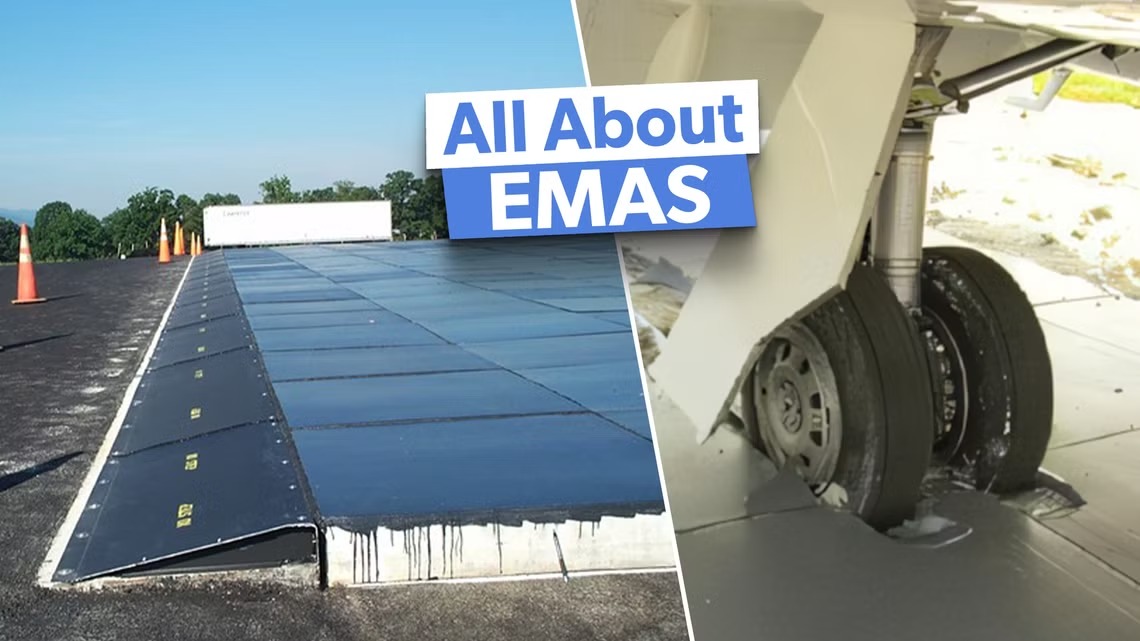If an aircraft is to overrun a runway, using EMAS (Engineered materials arresting systems) allows the aircraft to sink into a lightweight material, which will help the plane rapidly decelerate.
The crushable material also absorbs kinetic energy and will bring an aircraft to a complete stop if it is traveling at less than 70 knots.
Slowing down over-run aircraft
An EMAS is located past the far end of the runway. It can be up to 500 feet in width and 1,000 feet in length. Many airports were built before the FAA introduced the RSA (Runway safety areas), which has meant research and varying designs to fit in with the local environments.
Initial research was completed in the 1990s, and now, where possible, airports are expected to meet the RSA standard.

In the 1990s, the Federal Aviation Administration started researching how to improve airport safety, including the feasibility of adopting a process for overrun aircraft.
It was expected that most commercial service airports would have these in place within the United States by 2015.
As expected, many airports were well established by this time, and it required feasibility studies on how to implement an EMAS system, where there would be limited space at the end of the runway, such as bodies of water, highways, railroads, or residential areas.
Benefits of EMAS
Installing EMAS can stop an aircraft that has overrun the runway as long as it travels at less than 70 knots or 80 miles per hour.
The ‘arrestor bed,’ made of crushable materials, will crush under the aircraft’s weight, slowing the plane down to a complete stop. The arrestor bed can help slow or stop the aircraft, regardless of whether the EMAS area is up to 1,000 feet long, depending on each scenario.

According to the Federal Aviation Administration, the EMAS system has aided 15 overrunning aircraft to come to a complete stop safely, saving over 406 passengers and crew. The most recent incidents include:
- Cleveland Burke Lakefront Airport (BKL), Ohio, February 2018: Beech Jet 400A, with four passengers and crew onboard, over-running the runway.
- Hollywood Burbank Airport (BUR), California, December 2018: Boeing 737 with 117 passengers and crew overran the runway.
- Kansas City International Airport (MCI), Missouri, February 2019: Embraer Phenom 100 overran the runway with just one pilot onboard.
With this information, let’s understand five things to know about the EMAS (Engineered materials arresting systems):
1. Located at 66 airports in the United States
Implemented on 111 runways
The EMAS is currently in operation at 66 airports across the United States, and its installation dates from 1996 to 2019. The first recorded by the Federal Aviation Administration was at New York John F. Kennedy Airport (JFK) in 1996. The most recent airports were:
- Clinton National Airport (LIT) Little Rock, AK, one EMAS replaced in 2018
- Waterbury-Oxford Airport (OXC), Connecticut, one installed in 2018
- Hilton Head Airport (HHH), South Carolina, two installed in 2019
2. greenEMAS systems installation
Formed using recycled materials
Installed during the fall of 2014 through 2016, four greenEMAS systems were implemented at Chicago Midway International Airport (MDW). A greenEMAS is a system formed by:
- Recycled glass
- High-strength plastic mesh
- Anchoring to the pavement
- Foamed silica

The installation process involves foamed silica being poured into the lanes, covered by recycled materials and mesh, and then a cement layer being poured overtop.
3. Reducing the risks of over-running aircraft
Up to 1,000 feet in length
The recommended length of an EMAS is 1,000 feet by 500 feet in width. The system is installed at the end of the runway to reduce the potential risk of an overrunning aircraft; at airports where the area at the end of the runway cannot accommodate the entire length of an EMAS system, a shorter option may be installed, still aiding in the slowdown of an aircraft excursion.

Subject to the AC 150/5220-2B standards for planning, design, and installation of EMAS, must meet these below requirements (list not exhaustive):
- Be built from fire-resistant and non-toxic materials
- Be able to resist jet blast
- Not impeding transit for RFFS vehicles
- Able to withstand abient climates (such as extreme heat and freezing temperatures)
- Designed and installed using a verified systems performance model
4. Development of the EMAS
SAS Flight 901
Following the overrun of a Scandinavian Airlines DC10-30 at New York John F. Kennedy Airport in 1984, where the aircraft had a late touchdown at the New York airport, leading to the plane overrun 04R, they led to the development of the EMAS. The incident saw the aircraft encounter extensive damage and multiple passenger injuries.

At the time, the FAA and the United States Air Force looked into the feasibility of a soft grounded arresting system for the end of airport runways.
Experiments were undertaken to help design the system, and initial tests were completed on phenolic foam and cellular cement with an FAA Boeing 727. In 1994, the FAA and JFK Airport developed and installed one of the prototype arrestor beds on runway 04R.
| Runway | First installation | Replacement of EMAS |
|---|---|---|
| 04R | 1994 | 1999 |
| 22L | 2007 | 2014 |
5. Design factors
Varying subject to local conditions
Each EMAS is designed to consider the length, width, elevation, slope, and performance of each runway. Most installations will include a maximum 70-knot entry bed speed.
Most airports will have more than 500 aircraft movements per year, and the subsequent aircraft will use between 80% and 100% of the runway’s maximum landing weight.

The EMAS bed will slope downward and include assumptions that:
- Aircraft will still be attempting to decelerate themselves at the time of entry to the EMAS
- Reverse thrust will not be used
- Aircraft landing gear has minimal or no structural damage
Pilots are guided to use the EMAS when a runway over-run is imminent. Guidance is to follow the runway centreline (where possible) and not attempt to move the aircraft. Once the EMAS bed has been breached, the aircraft’s weight will crush the bed underneath.
Source: Simple Flying

Warning: Illegal string offset 'cookies' in /home/u623323914/domains/eng.bayviet.com.vn/public_html/wp-includes/comment-template.php on line 2564